List of tallest Gopurams
A Gopuram or Gopura is a monumental tower, usually ornate, at the entrance of any temple, especially in Southern India. This forms a prominent feature of Koils, Hindu temples of the Dravidian style.[1] They are topped by the kalasam, a bulbous stone finial. They function as gateways through the walls that surround the temple complex.[2]
The gopuram's origins can be traced back to early structures of the Tamil kings Pallavas and by the twelfth century under the Pandya rulers these gateways became a dominant feature of a temple's outer appearance, eventually overshadowing the inner sanctuary which became obscured from view by the gopuram's colossal size.[3] It also dominated the inner sanctum in amount of ornamentation. Often a shrine has more than one gopuram.[4]
A koil may have multiple gopurams, typically constructed into multiple walls in tiers around the main shrine.
Tallest Gopurams
Gopurams are widespread in south Indian temples, predominantly in Tamil Nadu.[5]
| S.No | Temple | Image | Height ft |
Year | Notes | Location |
|---|---|---|---|---|---|---|
| 2 | Sri Ranganathaswamy Temple | .jpg) |
239.501[6][7] | 1987 A.D.[6] | The Srirangam Temple is the largest temple in Asia and it houses the tallest gopuram in the country. The temple occupies an area of 156 acres[8] | Srirangam, Tamil Nadu, India |
| 1 | Murudeshwara Temple | 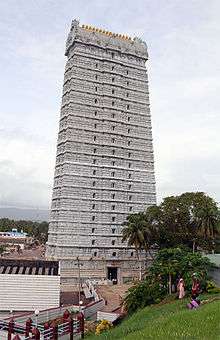 |
249[9] | 2008 A.D. | The temple is popular among travellers for the pretty high Siva temple, which is towered over an immense 40m high idol of the deity. The gopuram is second tallest in India[10] | Murudeshwar, Karnataka, India |
| 3 | Annamalaiyar Temple | |
216.5[11] | 9th century A.D. | The temple covers some 10 hectares, this vast temple is one of the largest of India. Four large unpainted gopurams, one of each cardinal point, front of approaches, with the eastern side rising 13 storeys and an astonishing 66m[12] | Tiruvannamalai, Tamil Nadu, India |
| 4 | Srivilliputhur Andal Temple | 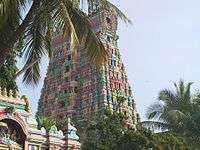 |
193.5[13] | A.D. | The 11-storied gopuram has a height of 59m, making it the tallest gopuram of the era. During the period of Madurai Nayaks, the lesser figures sponsored religious projects, including large scale campus.[14] The temple is the emblem of the Government of Tamil Nadu[13] | Srivilliputhur, Tamil Nadu, India |
| 5 | Ulagalantha Perumal Temple |  |
192 | AD | This temple is dedicated to Sri Trivikrama - Ulagalanda Perumal, the fifth incarnation of Lord Vishnu. This temple tower is one of the tallest, measuring 192 feet in height. The Alwars Poigai Alvar, Bhoothathalvar & Peyalvar sang in praise of Lord Vishnu which formed the integral part of the Nalayira Divya Prabandham.
One of the special features is that one idol contains the forms of two Gods - front side as Chakratalwar with sixteen hands and the back side as Narasimhar.[15] |
Tirukoilur, Tamil Nadu, India |
| 6 | Ekambareswarar Temple |  |
190[16] | A.D. | This is Kanchipuram's largest temple with its tall gopuram, a highly visible symbol of Vijayanagar dynasty. The entire complex covers an area of 10 hecatres and has five courtyards.[17] | Kanchipuram, Tamil Nadu, India |
| 7 | Azhagar Kovil |  |
187 | A.D. | Azhagar Koyil is a temple dedicated to Lord Vishnu. In the outer gateway of the temple, there is a massive door that is rarely opened. Behind the door, Karupannaswamy, the subordinate of Lord Vishnu, although no image of Karuppanaswamy is present. The shrine is dedicated to Karupannaswamy. | Madurai, Tamil Nadu, India |
| 8 | Meenakshi Amman Temple |  |
170 | A.D. | The complex houses 14 gopurams(gateway towers) ranging from 45-50m in height, the tallest being the southern tower, 51.9 metres (170 ft) high[18] The temple has some very old sections but the largest part dates back to 17th century. The four gopurams are decorated with many figures from the Hindu pantheon; they can be seen from great distances.[19] | Madurai, Tamil Nadu, India |
| 9 | Sarangapani Temple | |
164 | A.D. | The temple is the largest Vishnu temple in Kumbakonam. The temple shrine, in the form of chariot was the work of the Chola kings during the 12th century.[20][21] | Kumbakonam, Tamil Nadu, India |
| 10 | Rajagopalaswamy Temple | |
154 | 1523-1575 A.D. | King Vijayaragava Naik built the main gopuram, the thousand pillar hall and the big compound encircling the temple. The details of all these are available in the inscriptions within the temple[22] | Mannargudi, Tamil Nadu, India |
| 11 | Sri Lakshmi Narasimha Swamy Temple, Mangalagiri | 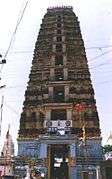 |
153[23][24] | 1809 A.D.[23] | Mangalagiri means The Auspicious Hill. This place is one of the 8 important Mahakshetrams (sacred places) in India[25] | Mangalagiri, Andhra Pradesh, India |
| 12 | Sankaranayinarkoil,Sankarankovil | 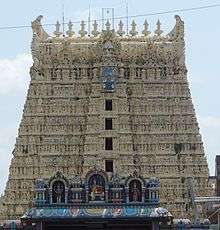 |
127 | 11th Century A.D. | Sankarankovil is home to the famous Sankaranarayanan Swamy temple.Sankarankovil is the second largest town in the district. It is very famous for "Adi Thabasu" festival. In older times, the city was called as Sankaranayinarkoil. Even now it is called as Sankarankovil. | Sankarankovil, Tamil Nadu, India |
| 13 | Nanjundeshwara Temple | |
120 | 9th Century A.D. | This is known as Dakshin Kashi or Kashi of South | Nanjundeshwara_Temple, Karnataka, India |
Tallest Vimanam
Vimanams are structures over the sanctum of temples, predominantly in Orissa and Tamil Nadu.[5] In many cases the vimanams are confused with gopurams. Vimanams are present above the Garbhagriha or Sanctum sanctorum in of a Hindu temple and will be relatively smaller in size compared to the gopurams, which are usually present at the entrance of the temple.
| Temple | Image | Height ft |
Year | Notes | Location |
|---|---|---|---|---|---|
| New Vishwanath Temple | 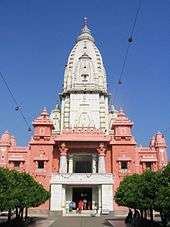 |
250[26] | 1966 | The Birla family undertook the construction and foundation was laid in March 1931. The temple (Shri Vishwanath Mandir) was finally completed in 1966. | Banaras Hindu University, Varanasi |
| Brihadeeswarar Temple |  |
216[27][28] | 11th Century A.D | The Peruvudaiyar Koyil or Brihadeeswarar Temple, also known as Rajarajeswaram,[29] at Thanjavur in the Indian state of Tamil Nadu, is the world's first complete granite temple[30] and a brilliant example of the major heights achieved by Cholas kingdom Vishwakarmas in dravidian temple architecture. It is a tribute and a reflection of the power of its patron RajaRaja Chola I. It remains as one of the greatest glories of Indian architecture.[31] The temple is part of the UNESCO World Heritage Site "Great Living Chola Temples". | Thanjavur, Tamil Nadu, India |
| Jagannath Temple, Puri |  |
216[32] | 1174 A.D. | The Jagannath Temple in Puri is a famous Hindu temple dedicated to Jagannath (Vishnu) and located in the coastal town of Puri in the state of Orissa, India. The name Jagannath (Lord of the Universe) is a combination of the Sanskrit words Jagat (Universe) and Nath (Lord of).[33]
The temple was built in the 11th century atop its ruins by the progenitor of the Eastern Ganga dynasty, King Anantavarman Chodaganga Deva. The temple is famous for its annual Rath Yatra, or chariot festival, in which the three main temple deities are hauled on huge and elaborately decorated temple cars. Since medieval times, it is also associated with intense religious fervour.[34] |
Puri, Orissa, India |
| Lingaraj Temple |  |
183.7[35] | 11th Century A.D. | Lingaraja Temple is a temple of the Hindu god Harihara and is one of the oldest temples of the Temple City Bhubaneswar, a revered pilgrimage center and the capital of the state of Orissa. The temple of Lingaraja, the biggest of all at Bhubaneswar is located within a spacious compound wall of latterite measuring 520 feet by 465 feet. The wall is 7 feet 6 inches thick and surmounted by a plain slant coping. Alongside the inner face of the boundary wall there runs a terrace probably meant to protect the compound wall against outside aggression.[36] | Bhubaneshwar, Orissa, India |
| Brihadisvara temple, Gangankonda Cholapuram, Tamil Nadu | 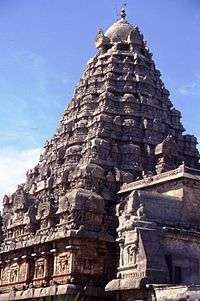 |
182[37] | 11th Century A.D | The Vimana with its recessed corners and upward movement presents a striking contrast to the straight-sided pyramidal tower of Thanjavur but with octagon shape of Dravidian architecture. As it rises to a height of 182 feet (55 m) and is shorter than the Thanjavur tower with larger plinth, it is often described as the feminine counterpart of the Thanjavur temple.
The Vimana is flanked on either side by small temples; the one in the north now housing the Goddess is fairly well preserved. The small shrine of Chandikesvara is near the steps in the north. In the north-east are a shire housing Durga, a well called lion-well (simhakeni) with a lion figure guarding its steps and a late mandapa housing the office. Nandi is in the east facing the main shrine. In the same direction is the ruined gopura, the entrance tower. The main tower surrounded by little shrines truly presents the appearance of a great Chakravarti (emperor) surrounded by chieftains and vassals. The Gangaikondacholapuram Vimana is undoubtedly a devalaya chakravarti, an emperor among temples of South India.[38] |
Gangaikonda Cholapuram, Tamil Nadu, India |
| Konark Sun Temple |  |
130[39] 230 before ruin[40] | 13th Century A.D. | Konark Sun Temple (also known as the Black Pagoda), was built in black granite by King Narasimhadeva I (1236 C.E-1264 C.E) of the Eastern Ganga Dynasty. The temple is a UNESCO World Heritage Site. Built in the 13th century, the temple is designed in the shape of a colossal chariot with 24 wheels (3.3 m dia diameter each) drawn by seven horses and, carrying the Sun god, Surya, across the heavens. It is a stunning monument of religious (Brahmanical) kalinga architecture. The large structure seen today is actually the mantapa (mandap). Of the main tower, which once stood in the front, only the remains can be seen. This tower (deul) was perhaps 230 feet (70 meters) tall, higher than any other temple in India. | Konark, Orissa, India |
Notes
- ↑ Ching, Francis D.K.; et al. (2007). A Global History of Architecture. New York: John Wiley and Sons. p. 762. ISBN 0-471-26892-5.
- ↑ Ching, Francis D.K. (1995). A Visual Dictionary of Architecture. New York: John Wiley and Sons. p. 253. ISBN 0-471-28451-3.
- ↑ Mitchell, George (1988). The Hindu Temple. Chicago: University of Chicago Press. pp. 151–153. ISBN 0-226-53230-5.
- ↑ "gopura". Encyclopædia Britannica. Retrieved 2008-01-20.
- 1 2 108 Vaishnavite Divya Desams: Divya desams in Pandya Nadu. M. S. Ramesh, Tirumalai-Tirupati Devasthanam.
- 1 2 Chand 1987, p. 36
- ↑ A new Rajagopuram Frontline Magazine, 4–17 April 1987.
- ↑ Yatra2Yatra. Sanjay Singh.
- ↑ Singh 2009, p. 271
- ↑ South India P.271. Sarina Singh
- ↑ Singh 2009, p. 1069
- ↑ South India P. 418. Sarina Singh
- 1 2 Tourist guide to Tamil Nadu 2007, p. 109
- ↑ Architecture and art of southern India: Vijayanagara and Successor States, Volume 1, Issue 6P.112. George Michell
- ↑ http://www.indian-heritage.org/temple/tirukoil.htm
- ↑ Sajnani 2001, pp. 305
- ↑ India P.545. Karen Schreitmüller
- ↑ Sajnani 2001, pp. 307-308
- ↑ India P.586. Karen Schreitmüller
- ↑ South India P.432. Sarina Singh
- ↑ Temples of South India P.112. V.V. Subba Reddy
- ↑ Power of Passion P. 4. S. Manickavasagam
- 1 2 Chand 1987, p. 36
- ↑ A new Rajagopuram Frontline Magazine, 4–17 April 1987.
- ↑ Yatra2Yatra. Sanjay Singh.
- ↑ "Vishwanath Mandir, BHU".
- ↑ Middle Chola Temples, S.R. Balasubrahmanyam
- ↑ CBSE textbook on Social Studies Class 10
- ↑ South Indian Inscriptions - VolII, Part I& II
- ↑ http://india.gov.in/myindia/facts.php
- ↑ Atlas of the Year 1000 - Page 105 by John Man
- ↑ The Jagannatha Temple at Puri: its architecture, art, and cult.O. M. Starza
- ↑ Vedic Concepts "An example in Sanskrit is seen with the word Jagat which means universe.] |accessdate=2006-09-12
- ↑ "Jagannath Temple History". Time. 1959-07-20.
- ↑ Land and people of Indian states and union territories: in 36 volumes. Orissa .S. C. Bhatt, Gopal K. Bhargava
- ↑ Ramesh Prasad Mohapatra (1986) Page 69. Archaeology in Orissa Vol I. B. R. Publishers, Delhi ISBN 81-7018-346-4
- ↑ Nagasamy R, Rajapalayam (1970), State Department of Archaeology, Government of Tamil Nadu
- ↑ "Gangankonda Cholapuram Temple History". Time. 1959-07-20.
- ↑ http://www.eodisha.com/height-of-sun-temple-konark-in-orissa/
- ↑ http://konark.nic.in/maintemple.htm
References
- Chand, Attar (1987), The great humanist Ramaswami Venkataraman, Delhi: Gian Publishing House, ISBN 81-212-0106-3.
- Sajnani, Dr. Manohar (2001), Encyclopedia of tourism resources in India, Volume 2, Delhi: Kalpaz Publications, ISBN 81-7835-014-9.
- Singh, Sarina; Lindsay Brown; Mark Elliott; Paul Harding; Abigail Hole; Patrick Horton (2009), Lonely Planet India, Australia: Lonely Planet.
- Tourist guide to Tamil Nadu (2007), Tourist guide to Tamil Nadu, Chennai: T. Krishna Press, ISBN 81-7478-177-3.